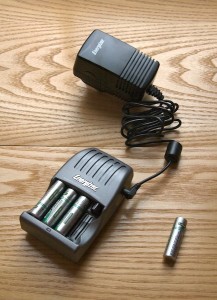 I’ve just bought a new battery charger, which recharges standard AAs or AAAs in 15 minutes. You may be able to see the grill behind the batteries – for ventilation. Yes, this is a charger with a 60W power supply and a built-in fan, which cools the batteries as they charge.
I’ve just bought a new battery charger, which recharges standard AAs or AAAs in 15 minutes. You may be able to see the grill behind the batteries – for ventilation. Yes, this is a charger with a 60W power supply and a built-in fan, which cools the batteries as they charge.
It certainly seems to work as advertised, but does anyone know if there are implications, good or bad, for the life of your batteries if you charge them this way?
I bought it here, by the way.
I was always under the impression that fast charging reduced the life and number of times you could re-charge the battery
The manufacturers of NiMH cells usually suggest fast charge at 1C, ie lasting 1 hour, followed by C/10 top-up for 30 minutes. The critical thing is having a good circuit to detect end of fast charge, especially if the cell is already partially charged. If the charger does not terminate fast charge the cells service life will shorten. Duracell and others recommend monitoring rate of temperature rise to determine when to terminate the fast charge. The good thing about the 15minute charger, I guess, is that it will be easier to detect the temperature rise assuming the charging circuit uses this method. dT/dt is a better indicator of end of charge than monitoring the cell voltage. So the summary, lets hope the monitoring circuit it good. Does it monitor the cell temperature?